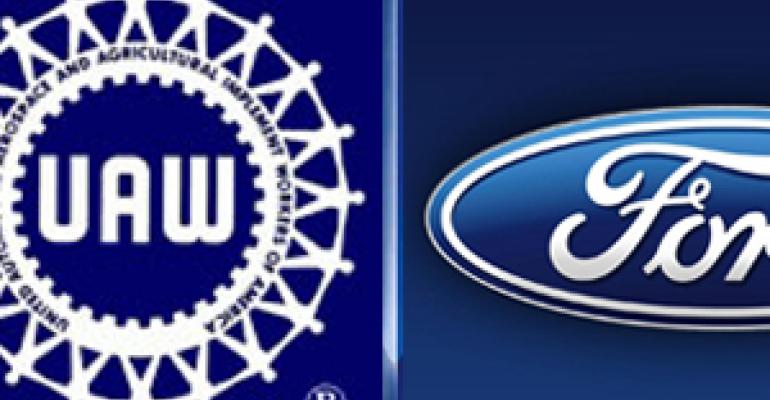Ford says the recently ratified contract with the United Auto Workers union will raise fixed labor costs less than 1% on an annual basis, but that likely hinges on productivity gains and an increased number of entry-level workers.
John Fleming, Ford executive vice president-global manufacturing and labor affairs, says in a conference call today the auto maker expects the contract will allow it to increase the number of entry-level, or tier-2 workers, to about 8% of its total workforce.
To meet that goal, Ford will take a number of steps, including offering buyouts to both non-retirement and retirement-eligible unionized employees beginning in January. Supplemental workers will be offered entry-level positions, further padding the total, he says.
Under the UAW agreement, entry-level workers make $15.78 an hour, increasing to $19.28 by the end of the 4-year agreement. In comparison, tier-1 workers make about $28 an hour.
The contract mandates that entry-level workers cannot comprise more than 20% of Ford’s total UAW workforce.
Production-efficiency gains are expected to result from several initiatives outlined in the contract, including new work practices such as alternative schedules and extra shifts. “This gives us a gap between production shifts for maintenance or overtime,” Fleming says of the new work practices. “It gives us an opportunity to do that on weekends, as well.”
Under the plan, teams will be formed to increase productivity. They will be composed of production or skilled-trade workers, as well as teams integrating both classes of workers.
The teams are designed to get more work done in less time. In the past the work flow sometimes was stopped while waiting for the appropriate skilled-trade worker.
“It’s all about continuing the evolution of the production system and introducing production teams in a broader way,” Fleming says. “We know it works because we have some plants that have adopted it, and it has increased the overall profitability of those individual plants.”
UAW-represented workers receive an immediate $6,000 ratification bonus, plus $6,000 in annual inflation-protection and competitive lump-sum payments starting next year. They also will receive a $250 annual bonus if quality objectives are met.
Mark Fields, Ford president-The Americas, says the lump-sum bonuses to UAW members will cost the auto maker about $280 million this year. For the remainder of the contract, inflation and performance bonuses will cost about $80 million a year, he says.
Additionally, UAW members will receive profit-sharing in line with that of the auto maker’s salaried employees. Fields says UAW members will receive $1 for every $1 million of the company’s annual pretax profits, with a cap of $12,000.
Fields says Ford also plans to in-source a number of new products to U.S. plants. For example, it will move production of its F-650 and F-750 medium-duty trucks from Escobedo, Mexico, to its Ohio Assembly Plant in Avon Lake, OH.
The F53 motor-home chassis and F50 commercial-striped chassis also will be brought in-house, with Ford investing $128 million in the Ohio facility. The medium-truck manufacturing shift will make Ford the only U.S. full-line manufacturer of Class-6 and -7 medium-duty vehicles, it says.
“By moving our commercial-vehicle production in-house, we will be able to streamline and strengthen the engineering and manufacturing of our next-generation medium-duty trucks,” Fields says.




